NYC’s Forgotten ‘War on Christmas Trees’
Discover how an obscure holiday crackdown affects festive street vendors today!


While New York City is an exciting and energetic city, the chaos of all the noise and people can get quite frustrating. Luckily, there are 7 botanical gardens throughout the city to offer you some respite. One of them is the Brooklyn Botanic Garden in the Prospect Park neighborhood. At 39 acres it may not be the largest, but it is still rather beautiful with various exhibits for all ages and people. It also offers some nice perks, such as an annual Cherry Blossom Festival, Chile Pepper Festival, and many other fun events. In honor of the warm weather and coming spring, we put together our top 10 secrets of the Brooklyn Botanic Garden.
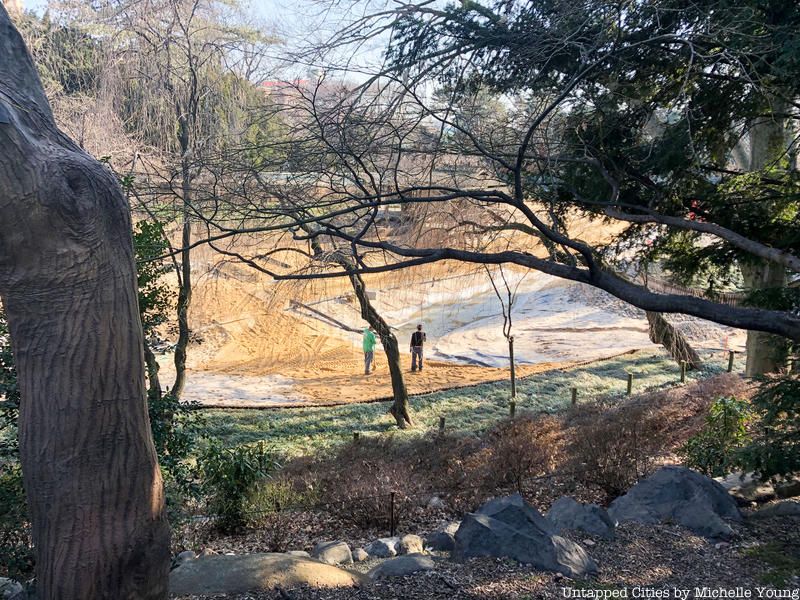
The Japanese Hill-and-Pond Garden under re-construction
Before the intense development of New York City, Long Island, Manhattan and the Bronx were a marshy wasteland shaped by the Wisconsin Iceberg. Once development started, the marsh was transformed into a bustling city. The land around what would become was converted into Prospect Park in a land acquisition in 1864, but the land that would eventually be the Brooklyn Botanic Garden was an ash dump throughout the 1800s (like the Corona Ash Dump, forever immortalized as the Valley of Ashes in The Great Gatsby).
The 39-acre land would become reserved by the State of New York for a garden, but would not begin developing into one of the best representations of urban gardening and horticultural display until 1911 when a local flora section, today the Native Flora Garden, was laid out.

Frederick Jr. and John Charles Olmsted, the sons of Frederick Olmsted, one of the famed designers of Prospect Park and Central Park, designed the original plans for the Brooklyn Botanic Garden. The Olmsted brothers provided the groundwork design, but did not go on to design the rest of the garden. In 1912, Harold Caparn took charge as the consulting landscape architect. The project would become his greatest achievement.
Caparn, who envisioned the garden to be an artistic and educational facility, let much of nature do the work, letting it grow over the course of a few decades, while he refurbished sections and added new sections as needed. When he left in 1945, the facility had grown to include 13 separate gardens, buildings, and museums.
Caparn also left his mark throughout the city by helping design landscape sections and the Great Steps of the Bronx Zoo, as well as design other parks around the city and neighboring areas, such as Grant and Columbus Parks in Yonkers, John Jay Park on the Upper East Side, and Lincoln and Milford Parks in Newark, NJ.
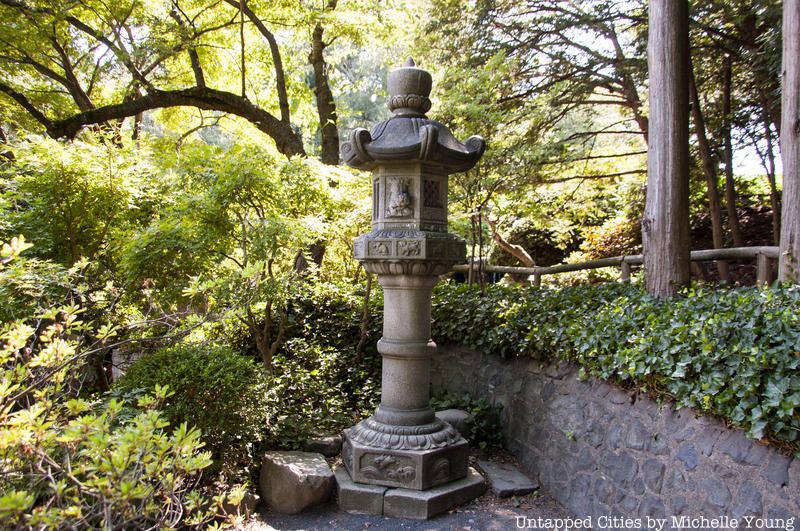
In the Japanese Hill-and-Pond Garden is a 500-year-old stone Shogun lantern given as a gift to New York City by the city of Tokyo in 1980. The 10-foot-high, 3 ton lantern was presented by Mr. Bunj Sakuma, a controller of the Taito Tokyo Ward to commemorate the 20th anniversary of the New York-Tokyo sister affiliation.
Long before the lantern was given to New York City, in 1925, feudal lord Naito Bunzen-no Kami dedicated this lantern to the Tokugawa shogunate.
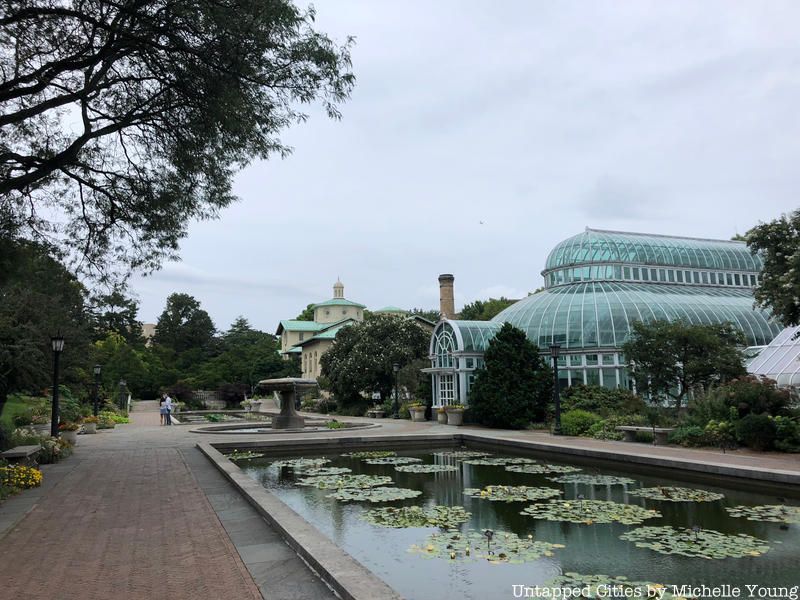
From 2002 to 2007, the Brooklyn Botanic Garden was the U.S. office of Botanic Garden Conservation International (BGCI). Founded in 1987, it is the largest plant conservation network in the world that connects 500 botanic gardens in 96 countries, and on every continent. They aim to “collect, conserve, characterise and cultivate samples from all the world’s plants as an insurance policy against their extinction in the wild and as a source of plant material for human innovation, adaptation, and resilience.”
In the United States, the BGCI works with gardens and conservation organizations around the country to raise awareness and increase scientific understanding of threatened plants in North America. The US office headquarters, formerly held in the Brooklyn Botanic Garden were moved to the Chicago Botanic Garden.
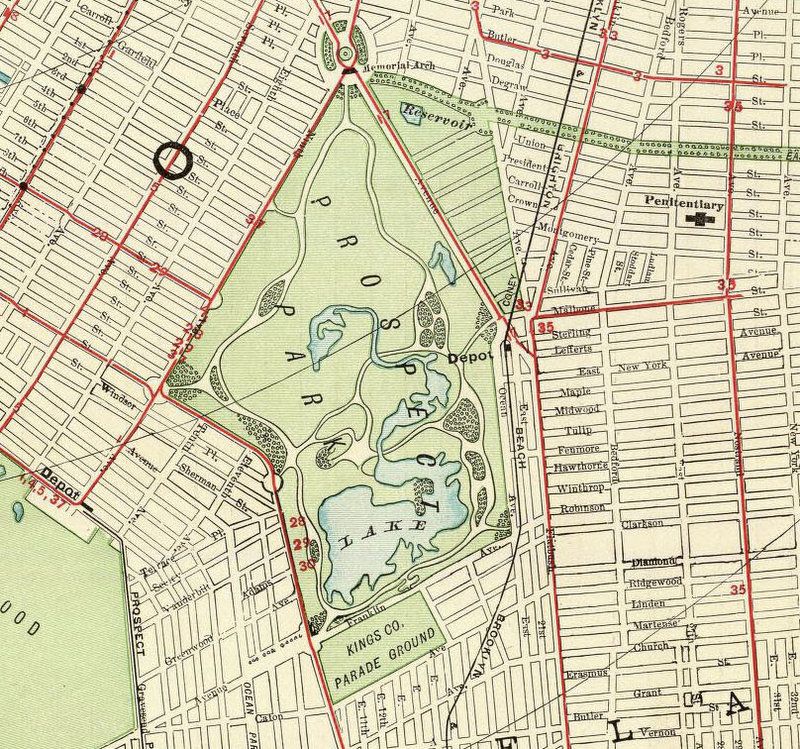
Map of Prospect Park in 1897. The triangular area in the northeast corner would become the botanic garden. Full map of Brooklyn can be found on Wikimedia Commons
June 15, 1864, the city of Brooklyn purchased the land for Prospect Park which also included the land bounded by Eastern Parkway, Empire Boulevard, Flatbush Avenue, and Washington Avenue which would become the Brooklyn Botanic Garden. The land went unused for many years after the acquisition until 1897 when New York State acquired the land for a garden.
In 1909, an agreement between the City of New York and Brooklyn Institute of Arts and Sciences (today, the Brooklyn Museum) created the garden.
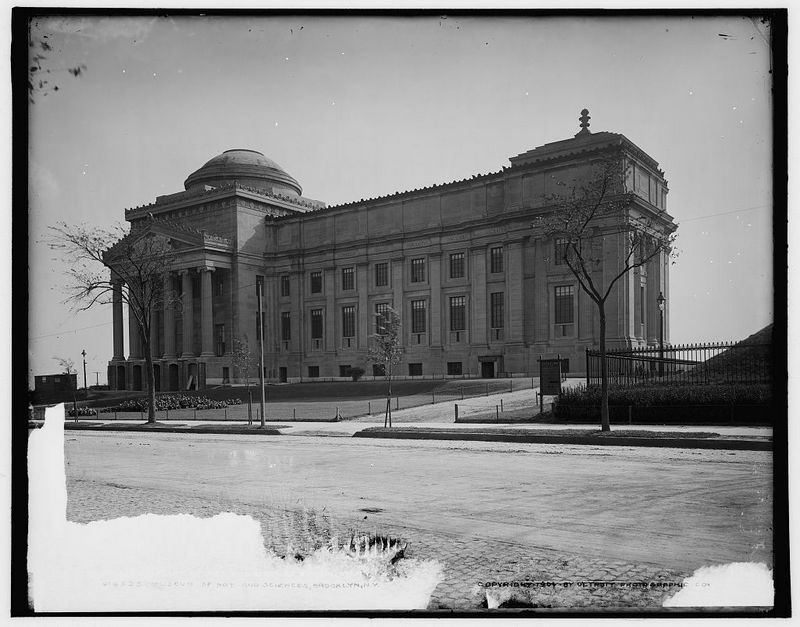
Museum of Arts and Sciences, Brooklyn, 1904. Image from Library of Congress
In 1910, management of the garden was assigned to the Brooklyn Institute of the Arts and Sciences (now the Broklyn Museum), carefully maintained by them until they separated in 1970s. Today, it is operated and maintained by an independent administration. Under the Brooklyn Institute of the Arts and Sciences, the garden went through a major transformation in its 60 year management, building the garden’s famed reputation.
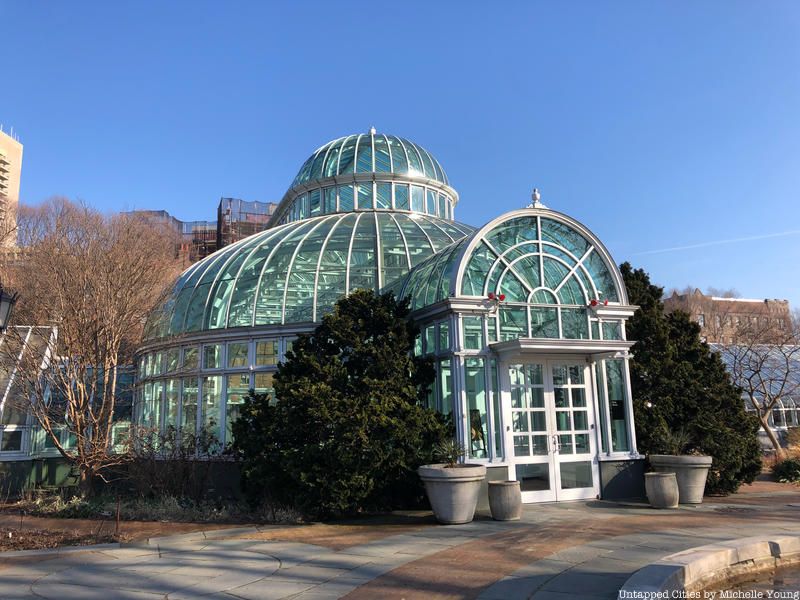
The Botanic Garden since its inception was committed to education. So in 1914 with an effort to maintain that mission and increase notoriety, the children’s gardening program was created. It became the first of its kind and the prototype for many such programs and gardens around the world. Today, kids between the ages of 2 and 17 continue to plant and harvest their own flowers and plants guided by garden instructors.
In 2014, the Brooklyn Botanic Garden was awarded the National Medal for Museum and Library Service on the 100th anniversary of the Children’s Garden. The Children’s Garden continues today to be a vital part of the Brooklyn community teaching the children and members about environmental awareness.
The Rock Garden was also the first public rock garden in the United States, opening in 1916. In 1992, more boulders were brought from Westchester County, NY to add to the original collection increasing the size of the already fairly large rock garden. Many of the boulders in this garden were deposited there during the last ice age and were subsequently unearthed and moved around during construction of various parts of the garden.
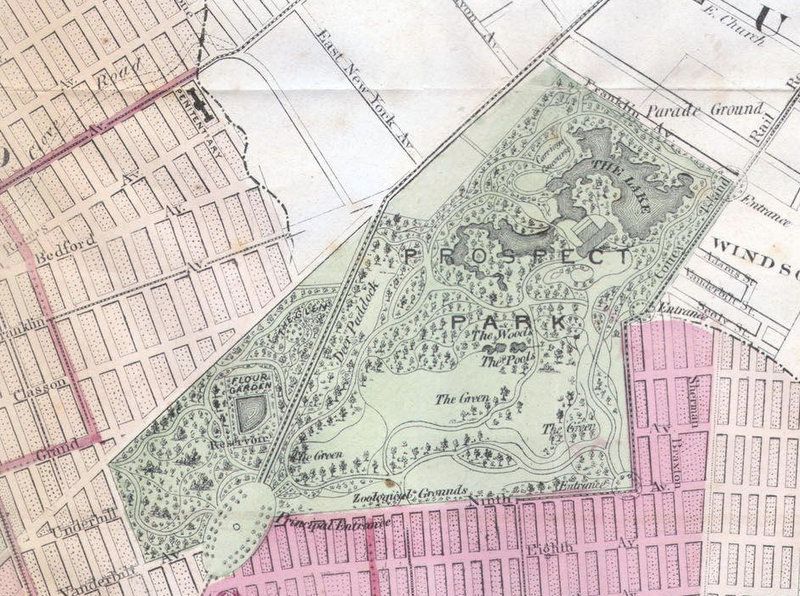
Prospect Park section of 1869 map of Brooklyn. Full map can be viewed on Wikimedia Commons
Before the Brooklyn Botanic Garden was established, and before New York State reserved that particular 39-acre plot of land in 1897, there were three other gardens planned that were never complete. The first one was created in 1825 by Andre Parmentier in the Prospect Heights section of Brooklyn. In 1855, a prominent Brooklynite, Thomas Hunt, launched an effort to create a botanic garden.
The latter garden was to be built between Fifth and Sixth Avenues and 57th and 60th Street had the additional $87,500 endowment from Parmentier’s garden together with funds from Henry A. Kent, yet even with all that money, the project was never able to get off the ground. Little is known about the third plan except that it was to be built near the Litchfield Mansion within the borders of Prospect Park. It appeared on an 1869 city map of Brooklyn, but not any maps in the years following.
With the creation of Prospect Park, the idea of separate botanic garden came to mind and the efforts by citizens and the state allowed the development of the Brooklyn Botanic Garden as we know it today.
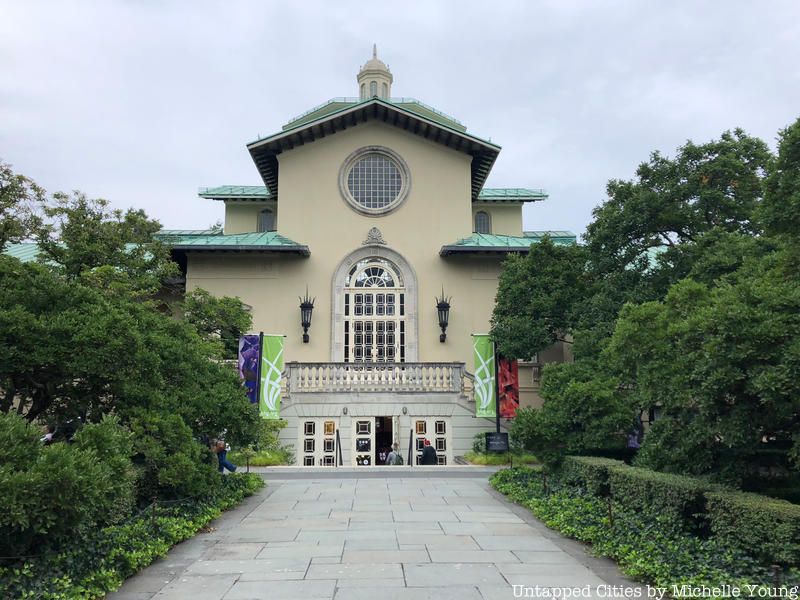
The Laboratory/Administration Building was made New York Landmark in 2007 because it is the most significant building from the garden’s first phase of development. Built between 1912 and 1916, the building is modeled after small churches in the Lombardy region of Italy and is constructed in a Greek cross design with a cupola at the center.
The building was designed by the William Kendall, a part of the famous renowned architectural firm McKim, Mead & White, which makes this building a significant part of the firm’s late work. The Olmsted Brothers’ firm worked with McKim, Mead & White to site the administration building, along with conservatories, and various gardens in the new botanic garden.
Originally, the building housed a physiological laboratory, elementary laboratory, photographic operating room and dark room, research rooms, assembly rooms, and a basement for storage. Today, it operates as botanical and horticultural library, and has a visitors center, auditorium, and administrative offices.
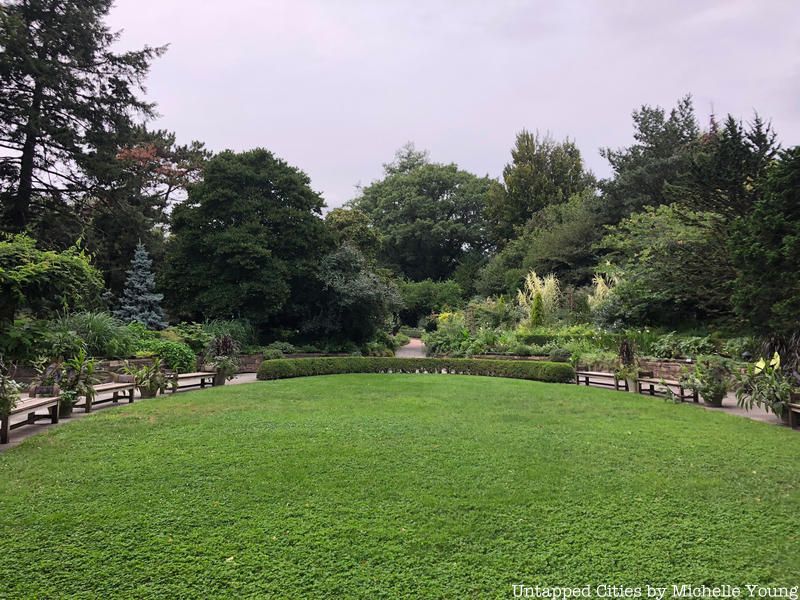 The Fragrance Garden is constructed in an oval-shaped space, 60ft by 100ft to let visitors come into close proximity with the plants.
The Fragrance Garden is constructed in an oval-shaped space, 60ft by 100ft to let visitors come into close proximity with the plants.
Designed by Alice Recknagel Ireys in 1955, the Fragrance Garden was the first garden in the whole of the United States to be built for the visually impaired where visitors are encouraged to touch and smell the plants which grow in raised beds to allow easy access for those in wheelchairs. The labels that identify the species of plants are also written in braille.
The garden is arranged into four main beds. Plants for Touch allows visitors to explore the differences in textured leaves, Plants With Scented Leaves release aromas when visitors gently rub the leaves and smell their fingers, Fragrant Flowers are on display during the midsummer, and Kitchen Herbs lets visitors smell culinary plants such as basil, chives, chocolate peppermint, dillm and sage.
Next, check out 7 NYC Botanical Gardens and the Top 12 Secrets of Prospect Park.
Subscribe to our newsletter